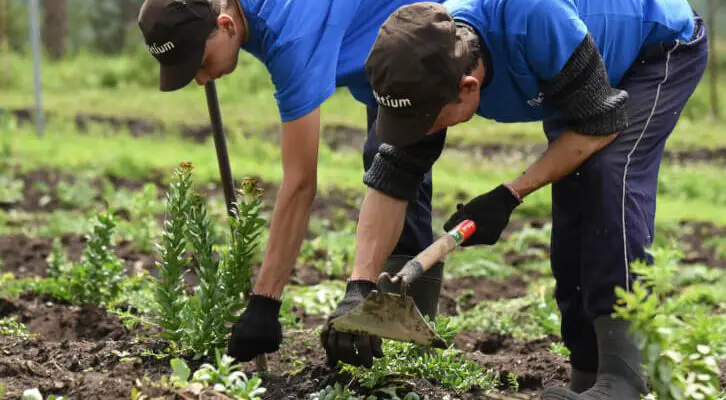Cultivating herbs year-round, particularly in chilly regions, presents a formidable challenge. However, by employing strategic techniques and structures, growers can mitigate the detrimental effects of low temperatures and diminished sunlight, unlocking the door to continuous productivity.
Modifying the Growing Environment
A comprehensive understanding of the growing environment is paramount for off-season cultivation success. Developing robust, balanced soil fertility is crucial, as it fortifies crops against the additional stressors of unconventional growing periods, which can swiftly decimate unprepared plants.
Protective Structures
Modern protective structures, such as polyethylene greenhouses and low tunnels covered with polypropylene row covers, have supplanted mainly traditional glass greenhouses and cold frames. These materials offer numerous advantages:
- Increased solar heat capture
- Retention of soil warmth
- Elimination of cooling winds
- Moisture barrier creation for drier growing conditions
While concerns exist regarding potential plastic compound leaching, the benefits often outweigh the risks, especially when coupled with a well-functioning soil environment’s natural decontamination capabilities.
Windbreaks and Drainage Management
Establishing appropriate windbreaks and optimizing drainage are critical components of successful cold-season growing. Raised beds, arranged strategically on slopes, promote efficient water removal, while subsurface tile drainage or perimeter ditches can further alleviate high groundwater levels common during winter months.
Capitalizing on Market Advantages
Year-round herb production offers a distinct competitive edge, as buyers highly value the consistency and availability of fresh produce, often taking precedence in their purchasing decisions.
Maximizing Output and Minimizing Costs
Continuous cultivation enables growers to maximize output from their growing areas, reducing the total acreage required and thereby minimizing operational costs. Additionally, this approach distributes the workload evenly throughout the year, ensuring ample tasks for employees during all seasons.
Premium Pricing Potential
When supply is limited, the potential for premium pricing increases substantially. By offering fresh herbs during periods of scarcity, growers can command higher prices, enhancing profitability and offsetting the additional investments required for year-round production.
Enhancing Flavor and Resilience
Certain herbs possess an innate ability to improve their flavor and resilience when exposed to cold temperatures, a trait that can differentiate locally grown produce from imports cultivated in warmer regions.
Cold-Induced Sweetening
As temperatures drop, many herbs, such as carrots, cabbages, parsnips, leafy greens, brussels sprouts, turnips, and rutabagas, initiate a process of starch conversion into simple sugars. This natural response increases the sugar content within the plant tissues, resulting in a delightful sweetening of flavor.
Frost Tolerance Variations
The degree of cold tolerance varies among herb species and varieties, as well as the overall plant vitality. Robust, well-nourished herbs are better equipped to withstand freezing temperatures by accumulating sugars and desiccating themselves, thereby preventing water crystallization and subsequent tissue damage.
Strategic Field Layout
Careful planning of the cold-season production area layout is crucial, as the low arc of the sun during winter months can create shading challenges and exacerbate drainage issues.
Optimizing Solar Exposure
Fields with full southern exposure and a gentle slope toward the sun can maximize sunlight capture during the cold season, providing optimal growing conditions. Strategically positioning beds and rows to minimize shading is essential for ensuring adequate light exposure.
Drainage and Soil Considerations
Raised beds, coupled with well-developed soil aggregation, can significantly improve drainage during the wetter winter months. Additionally, darker soil colors, often associated with increased fertility, possess enhanced heat absorption capabilities, further moderating soil temperatures.
Embracing Sustainable Practices
While modern protective materials offer numerous benefits, their environmental impact cannot be ignored. Growers should strive to strike a balance between productivity and sustainability, exploring eco-friendly alternatives and implementing responsible disposal methods.
Minimizing Plastic Waste
Polyethylene and polypropylene sheeting, though efficient and cost-effective, contribute to plastic pollution and potential soil contamination. Growers can mitigate these risks by:
- Utilizing aged materials, which tend to leach fewer compounds
- Implementing proper disposal methods
- Exploring biodegradable or reusable alternatives
Promoting Soil Health
Maintaining a well-functioning soil environment is crucial for successful year-round cultivation. Healthy soils not only support crop vitality and resilience but also possess natural decontamination capabilities, breaking down potential pollutants more effectively.
Cannabis Gardening Through the Seasons
Cannabis gardening through the seasons requires an understanding of the plant’s life cycle and how it responds to environmental changes. In spring, cannabis plants begin their journey with longer daylight hours, triggering their vegetative growth. Growers often start their seeds indoors to protect them from the late frosts and gradually acclimate them to outdoor conditions as temperatures warm. Summer brings peak vegetative growth, with long days providing ample sunlight. This is the time for diligent pest control, nutrient management, and ensuring plants have enough water to cope with the hotter weather. As fall approaches, the shorter days signal cannabis plants to enter the flowering stage. This critical phase demands close attention to environmental factors such as humidity and temperature, which can affect the development of buds. Growers Choice Seeds supports growers through these seasonal transitions by offering robust genetics that can withstand the fluctuations of outdoor growing, making them a reliable partner throughout the year.
Feminized cannabis seeds play a strategic role in cannabis gardening through the seasons. When using feminized cannabis seeds provided by Growers Choice Seeds, growers have the advantage of knowing that their efforts will be focused on plants that are all capable of flowering. Feminized cannabis seeds eliminate the guesswork and labor associated with identifying and removing male plants, which do not produce consumable buds. This efficiency is particularly valuable as the growing season progresses into late summer and early fall when plants are flowering, and energy can be concentrated on nurturing the developing buds. By choosing feminized cannabis seeds, growers are able to optimize their resources and attention to producing a bountiful, high-quality harvest.
Growers Choice Seeds stands out as a trusted seed bank in part due to its commitment to providing high-quality feminized seeds USA. These seeds are conducive to successful seasonal transitions in the cannabis garden. As the seasons change, so do the needs of the cannabis plants, and having a trusted seed source with proven genetics can make all the difference. Growers Choice Seeds assures that regardless of the season, their feminized cannabis seeds are bred to perform well under various climatic conditions, giving growers peace of mind and the ability to produce a successful crop year-round. Whether a gardener is preparing for the spring plantings or planning for the fall harvest, Growers Choice Seeds provides the quality and support needed to navigate the cannabis growing seasons effectively.
Cultivar Selection and Breeding
Selecting the appropriate herb varieties and engaging in targeted breeding efforts can significantly enhance cold-weather performance and yield potential.
Varietal Screening
Growers should carefully evaluate different herb cultivars for their suitability in cold-season production. Traits such as frost tolerance, sugar accumulation, and overall vigor should be prioritized when making selections.
Breeding Programs
Collaborative efforts with plant breeders can lead to the development of new herb varieties specifically adapted to year-round cultivation conditions. By focusing on desirable traits like cold hardiness, flavor enhancement, and disease resistance, growers can improve their chances of success.
Integrated Pest Management
While protective structures can shield herbs from many environmental stressors, pests, and diseases may still pose challenges. Implementing an integrated pest management (IPM) strategy is essential for maintaining crop health and productivity.
Monitoring and Scouting
Regular monitoring and scouting for pests and disease symptoms are crucial components of IPM. Early detection allows for timely intervention and can prevent widespread infestations or outbreaks.
Cultural Controls
Employing cultural control methods, such as crop rotation, proper sanitation, and the introduction of beneficial insects, can help disrupt pest and disease cycles without relying solely on chemical interventions.
Biological and Mechanical Controls
When necessary, growers can employ biological control agents, like predatory insects or microbial pesticides, or implement mechanical controls, such as traps or barriers, to manage pest populations while minimizing environmental impact.
Marketing and Branding
Successful year-round herb cultivation requires not only horticultural expertise but also effective marketing and branding strategies to differentiate products and capture consumer interest.
Emphasizing Freshness and Locality
Highlighting the freshness and local origins of year-round herbs can resonate with consumers seeking high-quality, sustainable produce. Emphasizing the unique flavors and nutritional benefits of cold-weather cultivation can further enhance product appeal.
Storytelling and Transparency
Consumers increasingly value transparency and connection with their food sources. Growers can leverage storytelling techniques to share their farming practices, sustainability efforts, and the challenges overcome in providing fresh herbs throughout the year.
Establishing Partnerships
Forming partnerships with local restaurants, grocery stores, or community-supported agriculture (CSA) programs can provide reliable outlets for year-round herb sales. These collaborations can also foster brand loyalty and create a dedicated customer base.
Continuous Learning and Adaptation
As with any agricultural endeavor, year-round herb cultivation requires a commitment to continuous learning and adaptation. Growers should remain open to new techniques, technologies, and research findings to refine their practices and stay ahead of emerging challenges.
Attending Workshops and Conferences
Participating in workshops, conferences, and educational events can expose growers to the latest advancements in year-round cultivation methods, pest management strategies, and marketing techniques.
Networking and Collaborating
Building a network of fellow growers, researchers, and industry experts can facilitate the exchange of knowledge, experiences, and best practices. Collaborative efforts can drive innovation and help address shared challenges more effectively.
Embracing Continuous Improvement
Successful year-round herb cultivation is an iterative process, requiring growers to continuously evaluate their practices, analyze results, and make necessary adjustments. Embracing a mindset of continuous improvement can lead to increased efficiency, higher yields, and long-term sustainability.
By implementing these strategies and embracing a holistic approach to year-round herb cultivation, growers can unlock a world of possibilities, providing fresh, flavorful produce throughout the year while contributing to a more resilient and sustainable food system.
Cultivating herbs year-round, particularly in chilly regions, presents a formidable challenge. However, by employing strategic techniques and structures, growers can mitigate the detrimental effects of low temperatures and diminished sunlight, unlocking the door to continuous productivity.
Modifying the Growing Environment
A comprehensive understanding of the growing environment is paramount for off-season cultivation success. Developing robust, balanced soil fertility is crucial, as it fortifies crops against the additional stressors of unconventional growing periods, which can swiftly decimate unprepared plants.
Protective Structures
Modern protective structures, such as polyethylene greenhouses and low tunnels covered with polypropylene row covers, have largely supplanted traditional glass greenhouses and cold frames. These materials offer numerous advantages:
- Increased solar heat capture
- Retention of soil warmth
- Elimination of cooling winds
- Moisture barrier creation for drier growing conditions
While concerns exist regarding potential plastic compound leaching, the benefits often outweigh the risks, especially when coupled with a well-functioning soil environment’s natural decontamination capabilities.
Windbreaks and Drainage Management
Establishing appropriate windbreaks and optimizing drainage are critical components of successful cold-season growing. Raised beds, arranged strategically on slopes, promote efficient water removal, while subsurface tile drainage or perimeter ditches can further alleviate high groundwater levels common during winter months.
Capitalizing on Market Advantages
Year-round herb production offers a distinct competitive edge, as buyers highly value the consistency and availability of fresh produce, often taking precedence in their purchasing decisions.
Maximizing Output and Minimizing Costs
Continuous cultivation enables growers to maximize output from their growing areas, reducing the total acreage required and thereby minimizing operational costs. Additionally, this approach distributes the workload evenly throughout the year, ensuring ample tasks for employees during all seasons.
Premium Pricing Potential
When supply is limited, the potential for premium pricing increases substantially. By offering fresh herbs during periods of scarcity, growers can command higher prices, enhancing profitability and offsetting the additional investments required for year-round production.
Enhancing Flavor and Resilience
Certain herbs possess an innate ability to improve their flavor and resilience when exposed to cold temperatures, a trait that can differentiate locally grown produce from imports cultivated in warmer regions.
Cold-Induced Sweetening
As temperatures drop, many herbs, such as carrots, cabbages, parsnips, leafy greens, brussels sprouts, turnips, and rutabagas, initiate a process of starch conversion into simple sugars. This natural response increases the sugar content within the plant tissues, resulting in a delightful sweetening of flavor.
Frost Tolerance Variations
The degree of cold tolerance varies among herb species and varieties, as well as the overall plant vitality. Robust, well-nourished herbs are better equipped to withstand freezing temperatures by accumulating sugars and desiccating themselves, thereby preventing water crystallization and subsequent tissue damage.
Strategic Field Layout
Careful planning of the cold-season production area layout is crucial, as the low arc of the sun during winter months can create shading challenges and exacerbate drainage issues.
Optimizing Solar Exposure
Fields with full southern exposure and a gentle slope toward the sun can maximize sunlight capture during the cold season, providing optimal growing conditions. Strategically positioning beds and rows to minimize shading is essential for ensuring adequate light exposure.
Drainage and Soil Considerations
Raised beds, coupled with well-developed soil aggregation, can significantly improve drainage during the wetter winter months. Additionally, darker soil colors, often associated with increased fertility, possess enhanced heat absorption capabilities, further moderating soil temperatures.
Embracing Sustainable Practices
While modern protective materials offer numerous benefits, their environmental impact cannot be ignored. Growers should strive to strike a balance between productivity and sustainability, exploring eco-friendly alternatives and implementing responsible disposal methods.
Minimizing Plastic Waste
Polyethylene and polypropylene sheeting, though efficient and cost-effective, contribute to plastic pollution and potential soil contamination. Growers can mitigate these risks by:
- Utilizing aged materials, which tend to leach fewer compounds
- Implementing proper disposal methods
- Exploring biodegradable or reusable alternatives
Promoting Soil Health
Maintaining a well-functioning soil environment is crucial for successful year-round cultivation. Healthy soils not only support crop vitality and resilience but also possess natural decontamination capabilities, breaking down potential pollutants more effectively.
Cultivar Selection and Breeding
Selecting the appropriate herb varieties and engaging in targeted breeding efforts can significantly enhance cold-weather performance and yield potential.
Varietal Screening
Growers should carefully evaluate different herb cultivars for their suitability in cold-season production. Traits such as frost tolerance, sugar accumulation, and overall vigor should be prioritized when making selections.
Breeding Programs
Collaborative efforts with plant breeders can lead to the development of new herb varieties specifically adapted to year-round cultivation conditions. By focusing on desirable traits like cold hardiness, flavor enhancement, and disease resistance, growers can improve their chances of success.
Integrated Pest Management
While protective structures can shield herbs from many environmental stressors, pests and diseases may still pose challenges. Implementing an integrated pest management (IPM) strategy is essential for maintaining crop health and productivity.
Monitoring and Scouting
Regular monitoring and scouting for pests and disease symptoms are crucial components of IPM. Early detection allows for timely intervention and can prevent widespread infestations or outbreaks.
Cultural Controls
Employing cultural control methods, such as crop rotation, proper sanitation, and the introduction of beneficial insects, can help disrupt pest and disease cycles without relying solely on chemical interventions.
Biological and Mechanical Controls
When necessary, growers can employ biological control agents, like predatory insects or microbial pesticides, or implement mechanical controls, such as traps or barriers, to manage pest populations while minimizing environmental impact.
Marketing and Branding
Successful year-round herb cultivation requires not only horticultural expertise but also effective marketing and branding strategies to differentiate products and capture consumer interest.
Emphasizing Freshness and Locality
Highlighting the freshness and local origins of year-round herbs can resonate with consumers seeking high-quality, sustainable produce. Emphasizing the unique flavors and nutritional benefits of cold-weather cultivation can further enhance product appeal.
Storytelling and Transparency
Consumers increasingly value transparency and connection with their food sources. Growers can leverage storytelling techniques to share their farming practices, sustainability efforts, and the challenges overcome in providing fresh herbs throughout the year.
Establishing Partnerships
Forming partnerships with local restaurants, grocery stores, or community-supported agriculture (CSA) programs can provide reliable outlets for year-round herb sales. These collaborations can also foster brand loyalty and create a dedicated customer base.
Continuous Learning and Adaptation
As with any agricultural endeavor, year-round herb cultivation requires a commitment to continuous learning and adaptation. Growers should remain open to new techniques, technologies, and research findings to refine their practices and stay ahead of emerging challenges.
Attending Workshops and Conferences
Participating in workshops, conferences, and educational events can expose growers to the latest advancements in year-round cultivation methods, pest management strategies, and marketing techniques.
Networking and Collaborating
Building a network of fellow growers, researchers, and industry experts can facilitate the exchange of knowledge, experiences, and best practices. Collaborative efforts can drive innovation and help address shared challenges more effectively.
Embracing Continuous Improvement
Successful year-round herb cultivation is an iterative process, requiring growers to continuously evaluate their practices, analyze results, and make necessary adjustments. Embracing a mindset of continuous improvement can lead to increased efficiency, higher yields, and long-term sustainability.
By implementing these strategies and embracing a holistic approach to year-round herb cultivation, growers can unlock a world of possibilities, providing fresh, flavorful produce throughout the year while contributing to a more resilient and sustainable food system.



